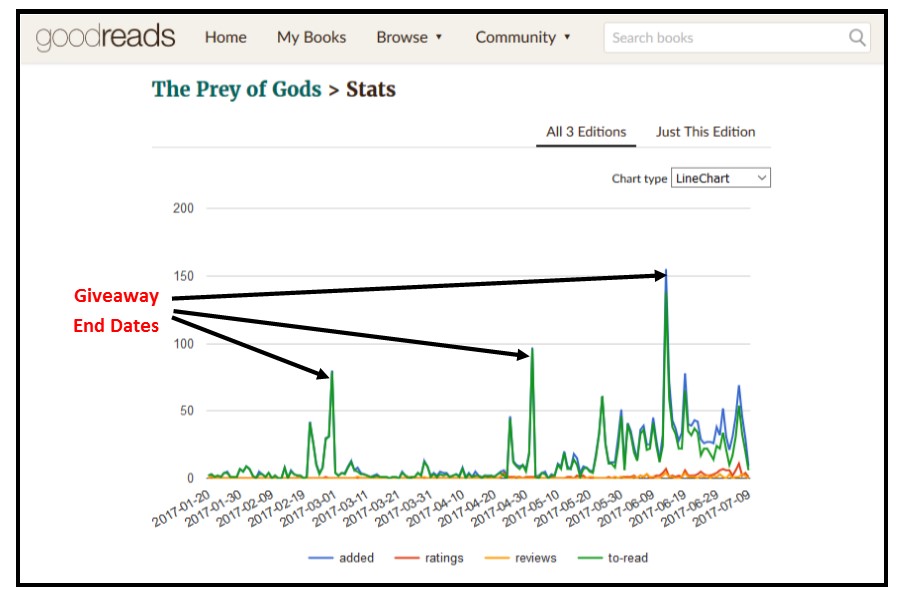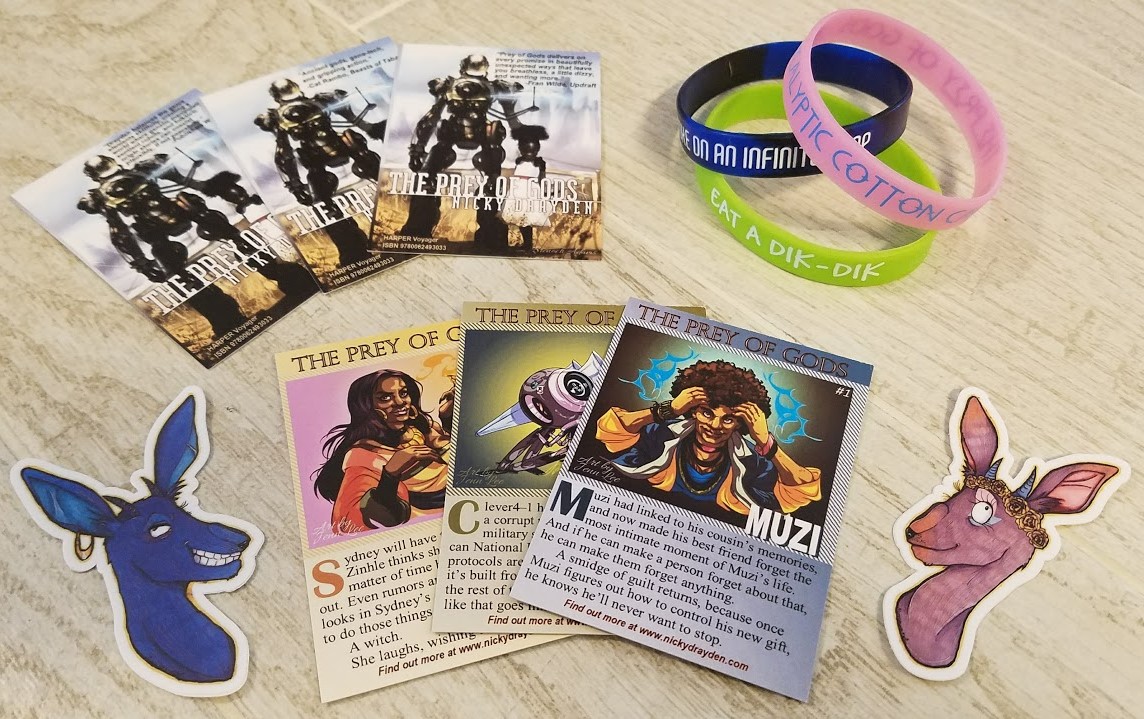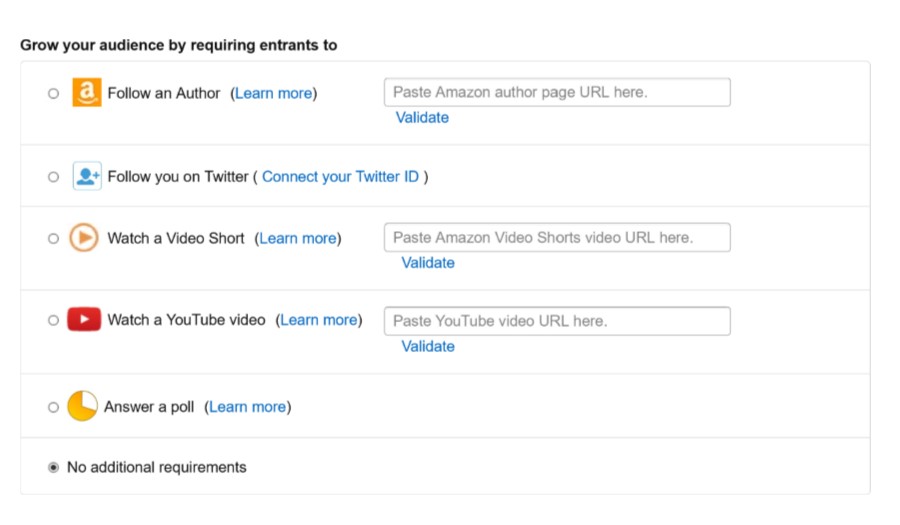Book Promotion on a $800 Budget
I’ve made it to the other side of my book launch, and things seem to be going very well, so I thought I’d share some of my book promotion techniques with you. THE PREY OF GODS launched exactly one month ago today, and I feel like I’ve learned a ton regarding what works and what doesn’t…at least for the short term. But I figure I need to write all this down now while it’s still fresh, so here it is.
First, I will state that I spent a lot more than $800 on my promotion. Some of it worked. Some was a waste in terms of money, though not in terms of experience. Plus, it was my first book birthday, so I splurged a bit. I’ll definitely be operating on a slimmer budget for the launch of book two, though, probably close to around $800. It’s a good chunk of change, but I think it’s a reasonable amount that can generate a lot of good will toward your book.
PUBLICITY SUPPORT
How you’ll spend your $800 budget will depend a lot on how much support you have in the publicity department. If you’re with a major publishing house, you’ll likely get a good deal of support and visibility without having to do a whole lot on your part. (And by not a whole lot, I mean promotions being only a part-time job for you instead of a full-time one.) If you’re with a small press, they’ll do some leg work for you, but you’ll likely be working just as hard if not harder to get your work in front of influential reviewers and bloggers. And if you’re an indie author, the work is 100% on your shoulders.
So I’ve broken down my budget for each of these promotional items below into three categories: Big House, Small Press, and Indie Author.
Note, these are just my personal observations, and I’ve been published a mere 30 days, so take this advice with a large grain of salt. It’s possible to get more support from an enthusiastic small press than a big house that thinks you’re meh, so feel free to follow whatever box you feel is the best fit for you. Or don’t follow any of them. Okay, now onto the budget.
ARC GIVEAWAYS AND EARLY REVIEWS:
Four to six months before your book launches, you want to start getting ARCs (Advance Reader Copies) into as many people’s hands as possible. These early reviewers will help generate buzz for your book and get other readers interested. The easiest way to do this is by holding giveaways on Goodreads. Goodreads is where readers congregate and socialize, so you get a lot of visibility through social shares. Plus, unlike Amazon, people can start leaving reviews and ratings as soon as the book is listed, and not just once launch day has arrived.
Aim to give away at least 30 physical ARCs through random giveaways and targeting bigger name reviewers. If you’re with a big house or small press, they should be offering some giveaways on their own and getting you reviewers, so you’ll just be supplementing as necessary. For these figures, I’m assuming it costs about $7 to ship each book and $8 per book copy beyond free books provided by the publisher. I’m also assuming if you’re with a big house, you’ll get at least 20 free copies of your book, 10 for small press, and 0 for indie authors.
I’d recommend doing three big pushes prior to launch, and two small giveaways (1-2 books each) in the months after launch. Goodreads users can mark your book as to-be-read when they enter the contest, which will make them much more likely to purchase your book. With each giveaway you should see more and more interest. Below you can see how much “to-read” numbers jump when there’s a giveaway. The smaller spikes are the start of the giveaways.
The first giveaway generated around 500 entries, the second around 650, and 900 for the third. The largest spike also coincided with my launch date. I figured since the last day of the giveaway gets most of the traffic, it would help drive momentum that day. I’m running my first post-launch giveaway right now and expect it to reach 1500 entries, so definitely keep up the push after your launch date.
To target professional reviewers, find 5-10 books on Goodreads that are similar to yours and see who’s reviewing them. Make a list of 25-35 reviewers and others that you’ve seen in the industry, and send out emails (or give the list to your publicist so they can send it out) offering ARCs in exchange for reviews. You’ll need some sort of sell sheet handy with your book’s cover, price, ISBN, description, blurbs, and other enticing material. Also, you can try to leverage e-copies (like through Edelweiss) or PDFs if you’re a indie author to cut down on some of the costs. If they’re not interested in a review, they still might be interested in doing a blog tour interview. Blog tours are great for getting a little extra visibility, and only cost your time.
BOOK LAUNCH TEAM:
 This was by far the funnest part of publication, getting your family and friends on board to cheer you on. Of course, if you’ve got awesome friends like mine, they’d be cheering you on anyway, but bringing these people together in a team amplifies their voices and gives them focus.
This was by far the funnest part of publication, getting your family and friends on board to cheer you on. Of course, if you’ve got awesome friends like mine, they’d be cheering you on anyway, but bringing these people together in a team amplifies their voices and gives them focus.
This was totally a last-minute idea that I started two weeks before launch, but I’d recommend starting 4-6 weeks out to give people a little extra time to read. Any further out and you risk losing momentum. I used social media to send out a call for team members and used a simple google form to collect their information. (You can check it out here.) It’s not too lengthy, but I did ask a few questions to make sure they were really committed to participating. That said, you’ll probably have three levels of participants:
- Champions. There will be a handful of people who go above and beyond the call of duty. They’ll blast their social media with every mention of your book. They’ll hound bookstore staff to put your book in a more prominent location. They’ll beg their local library to buy your book, and show up to all your signings with confetti and streamers. Champions are invaluable, so treat them kindly and be ever thankful for their help.
- All-Stars. About half of your team will be all-stars. They’ll read your book and review it within a month of the launch date. They’ll post selfies with your book on social media, and recommend it to their friends, co-workers, and book club. They’ll tweet their favorite quotes from the book, and laugh so hard at your awful puns that you’ll start to wonder if you’re a literary genius. All-stars are invaluable, so treat them kindly and be ever thankful for their help.
- Bench Warmers. Nearly half of your team will be bench players. They might not read your book, but they know what it’s about and are super excited for your success. They’ll like your Facebook and twitter posts. They’re content to cheer you on from the sidelines, but watch out–three years from now, one of them is going to be putting together a thousand goodie bags for their company’s annual Waffle Fest and think “Hey, my friend’s book Battle of the Breakfast Foods would be perfect for this!” Clutch City, baby. Bench players are invaluable, so treat them kindly and be ever thankful for their help.
Now you’ve got your players, ideally between 25 and 50, so the next step is to set your goals. Mine were to have fun and get 25 reviews on Amazon within a month of publication. Send out weekly emails towards these goals. Include pictures and acknowledge anyone who’s shown extra team spirit. You’ll probably be swamped during launch, so it’s good to compose the emails ahead of time. 6-8 emails over the course of a month or so is probably plenty. You don’t want to overwhelm the team.
The money I spent here includes sending off ARCs to a few lucky winners, mailing swag, and Amazon gift cards for coloring contest winners and team spirit awards. I didn’t offer ARCs to everyone, mostly because I only had a handful of books prior to launch, but if I had planned better, I would have offered e-copies for everyone through Edelweiss. It’s important to remember that your friends are not your customers, they’re a part of your team. They’re your cheerleaders, your voice, your arm-extender thingie for reaching stuff up on high shelves. So seriously, be ever grateful for them.
Here’s a compilation of images submitted by my awesome team members–images of their swag, selfies, and spottings of the book in the wild.
AND SPEAKING OF SWAG…
 This is where I went way over budget, and I’m not even a little bit sorry. I’ve been waiting for this moment for many, many years, so I wanted to celebrate hard. Had I stuck to my budget, I probably would have forgone the wristbands, and the nail files, and the coloring pages, and the music postcards and just focused on trading cards and stickers. Okay, maybe the wristbands, too, but just one style.
This is where I went way over budget, and I’m not even a little bit sorry. I’ve been waiting for this moment for many, many years, so I wanted to celebrate hard. Had I stuck to my budget, I probably would have forgone the wristbands, and the nail files, and the coloring pages, and the music postcards and just focused on trading cards and stickers. Okay, maybe the wristbands, too, but just one style.
Trading cards are awesome because they’re small and portable like business cards, they’re a good proportion to fit a book cover on one side and a bit of text on the reverse, and they make excellent bookmarks. Plus, if you have multiple character designs, you have a reason to give someone more than one card, and they might share that card with a friend.
Everyone loves stickers, but no one wants a sticker with your book cover on it, I don’t care how amazing it is. No one wants stickers with giant urls on them either. So what do you put on your sticker? Something visually appealing that relates to your book. I did a set of dik-diks, small antelopes native to South Africa, who make a huge appearance in the book. You’ll have to explain the significance to anyone who gets a sticker, but it’s a good conversation starter, and something people are willing to put on their laptops instead of pitching into the trash bin. Make sure you hand them out with a trading card that has all your branding and urls on it, so they’ll still have that connection.
Oh yeah, stickers are expensive. The best place I found for them if you’re going to order over 200 is StickerMule. If you’re going for a smaller run or want something less fancy, there are cheaper places. StickerMule is awesome though, especially since they give discounts for orders with multiple styles of stickers. I got my trading cards from PromoPrint. They came out a little darker than I wanted, but still really nice. Converting RBG to CMYK is a bit tricky since bright colors often don’t translate well, so you might want to order a test batch if you’ll be ordering thousands. Buy in bulk if you can. Often you’ll pay twice as much for 10x as many cards. I got my wristbands from Wristband.com. Great customer service, though the bands are a little smelly at first, so be prepared to let them air out in the garage for a week or two.
For trading card and sticker artwork, you can find artists who are willing to do commissions on Twitter. Check out the #commissions hashtag. Some of them are starving artists, so if you find someone whose art you adore and feel like you’re getting too good of a deal, throw a little extra change their way. Bonus points if you seek out artists from underrepresented groups. (Especially if your novel has people from those groups in it.)
AMAZON GIVEAWAYS
 Amazon giveaways are a great way to extend the reach of your promotion campaign and get your cover in front of new faces. Now, most of the faces you’ll get are people just looking for free stuff, but it has generated a few sales for me. I mostly look at it as a form of advertising. You don’t really care about the one person who wins the prize or if they read and review it. What you want is to craft an awesome message for the HUNDREDS of losers (that seems harsh) who will have a chance to download an ebook sample, and maybe read it. Amazon Giveaways are also great because you get actual books sales for the books you gift, which gives a little boost to your Amazon ranking.
Amazon giveaways are a great way to extend the reach of your promotion campaign and get your cover in front of new faces. Now, most of the faces you’ll get are people just looking for free stuff, but it has generated a few sales for me. I mostly look at it as a form of advertising. You don’t really care about the one person who wins the prize or if they read and review it. What you want is to craft an awesome message for the HUNDREDS of losers (that seems harsh) who will have a chance to download an ebook sample, and maybe read it. Amazon Giveaways are also great because you get actual books sales for the books you gift, which gives a little boost to your Amazon ranking.
Setting up a giveaway is easy. Just go to the page of the product you want to give away (it doesn’t even have to be your own book), scroll to the bottom and look for the giveaway button. Then you pick from an assortment of options. First select the number of prizes and your giveaway type:
 I’d recommend doing Lucky Number Instant Win, since it guarantees a set number (200 to 500 is a reasonable lucky number) will see your loser message before a winner is chosen, but I’ve also done Random Instant Win and Sweepstakes with similar results. I’d only recommend doing Random Instant Win if you’re giving away multiple books, though, since the odds will even out in your favor. More frequent giveaways with fewer books generates a lot more interest, since the most recent ones are listed first on the Amazon Giveaways page, and older ones get lost in the pile after a couple days.
I’d recommend doing Lucky Number Instant Win, since it guarantees a set number (200 to 500 is a reasonable lucky number) will see your loser message before a winner is chosen, but I’ve also done Random Instant Win and Sweepstakes with similar results. I’d only recommend doing Random Instant Win if you’re giving away multiple books, though, since the odds will even out in your favor. More frequent giveaways with fewer books generates a lot more interest, since the most recent ones are listed first on the Amazon Giveaways page, and older ones get lost in the pile after a couple days.
Next, you can require entrants to perform certain tasks before entering your contest. I didn’t bother with the Twitter followers options. I looked at the followers for a couple giveaways who require this, and they just have a lot of dummy account followers, which is not something that I’m interested in. I am interested in people following my Amazon author profile, though, so that’s pretty handy, since people will get email updates when your new book comes out. The polling option is another good one. The characters in my book all have super powers, so entrants got to pick their favorite power. If you’ve got a book trailer, you could use that, too.
I’d recommend running the giveaway for 2-4 days, so you can hold them more frequently. Also, since novel ebook prices can run up fast at $10 a pop, you might consider putting out an ebook collection of short stories (links to an expired giveaway) or a tie-in novelette using Kindle Direct Publishing. Check with your publishing house before you do this though. If you set this up 4-6 months out, you can start giving away your ebooks prior to your novel’s launch, and it’s a lot cheaper since you set the price, and also will get back royalties. The price of my short story collection is $2.99, and I get about $2 of that for each book I giveaway, so I’m only spending a dollar to reach 400 or so potential readers. Plus I typically get one purchase for every two books I giveaway, so I basically break even using this method. I only experimented with giving away the ebook version so I wouldn’t have added shipping costs, and I hoped I wouldn’t get people who just wanted a physical book to resell, plus all of my other giveaways were paperbacks, so I thought it evened things out a bit.
AND FINALLY, ADS!
 I just started playing with ads last week, so the jury is still out on this one. My friends and publicists have done an excellent job getting the book its initial exposure (Thanks so much, everyone!) and now I’m ready to extend my reach. Ads seem to work best if they’re vetted, so setting up an ad to a book that has 3 reviews isn’t going to be as effective as one that has 25. For this reason, I’d recommend saving the ad campaign until after the first couple weeks have passed.
I just started playing with ads last week, so the jury is still out on this one. My friends and publicists have done an excellent job getting the book its initial exposure (Thanks so much, everyone!) and now I’m ready to extend my reach. Ads seem to work best if they’re vetted, so setting up an ad to a book that has 3 reviews isn’t going to be as effective as one that has 25. For this reason, I’d recommend saving the ad campaign until after the first couple weeks have passed.
Facebook Ads
I’ve done one Facebook Ad so far. I don’t expect a dollar-for-dollar return on this one, but the whole of advertising is a bit like a mysterious black box that you throw money into and hope for the best. I went for the soft sale, boosting a post of a summer reading list put out by the Wall Street Journal that featured my book. When the list originally appeared, it gave me a huge boost in sales, so I figured if I was going to send anyone to a site via an ad, that should be it.
Facebook said I’d have an estimated 33,000 views, but I’ll probably actually only get a tenth of that. Halfway through the ad, about 50 people have clicked the link, and I’ve paid around $25 so far, so that works out to about 50 cents per click, which is kinda on the pricey side. I might have better luck with a different ad, so I’ll definitely try it again, though, probably I’ll only spend $10 per boost.
Goodreads Ads
I’ve also done one Goodreads ad campaign. It’s not as slick an interface as Facebook, but the results seem to be pretty similar. This one takes a bit more of a learning curve, though. I tried specifically targeted categories that my book fit into and readers who’ve rated similar authors, but both of those methods only netted me a few hundred impressions a day. On average, 1 person out of 2000 will click on the ad, so those numbers weren’t going to get me anywhere fast. I removed the filters and just targeted all Goodreads users, and am now getting 27,000 impressions per day, and about 20 clicks per day.
Here, you can set how much you want to pay per click, with a minimum of 10 cents and a recommended average of 50 cents. I chose 25 cents to start out with, but will probably play with it to see how to get the best value for my money. You can also have multiple ads pulling from the same budget, so you can try a lot of different ad phrasings to see what works best. I’ve got 7 different ads, and so far it seems accolades get a lot more clicks than book titles, so if you’ve gotten some good press online, link to that. I’ve also linked to Goodreads giveaways and sample chapters.
It’s too soon to tell if any of these ads have had any impact on sales, but at least 100 people have shown some interest and are now aware that my book exists, and that’s half the battle.
CONCLUSION
If this seems like a lot to manage, it totally is. My publicity team is amazing, and I’ve still been putting in at least 20 hours a week on promoting the book. The months before and after your book launch will demand most of your free time, so try to clear your schedule as much as you can. Thirty days after my launch, I feel like I’m ready to settle into my new normal as a published author, and get back to things I’ve neglected, like housework, and seeing daylight, and you know…writing.
If you’ve got any questions or comments, feel free to leave them below. Thanks so much for reading, and good luck with your book launch!







